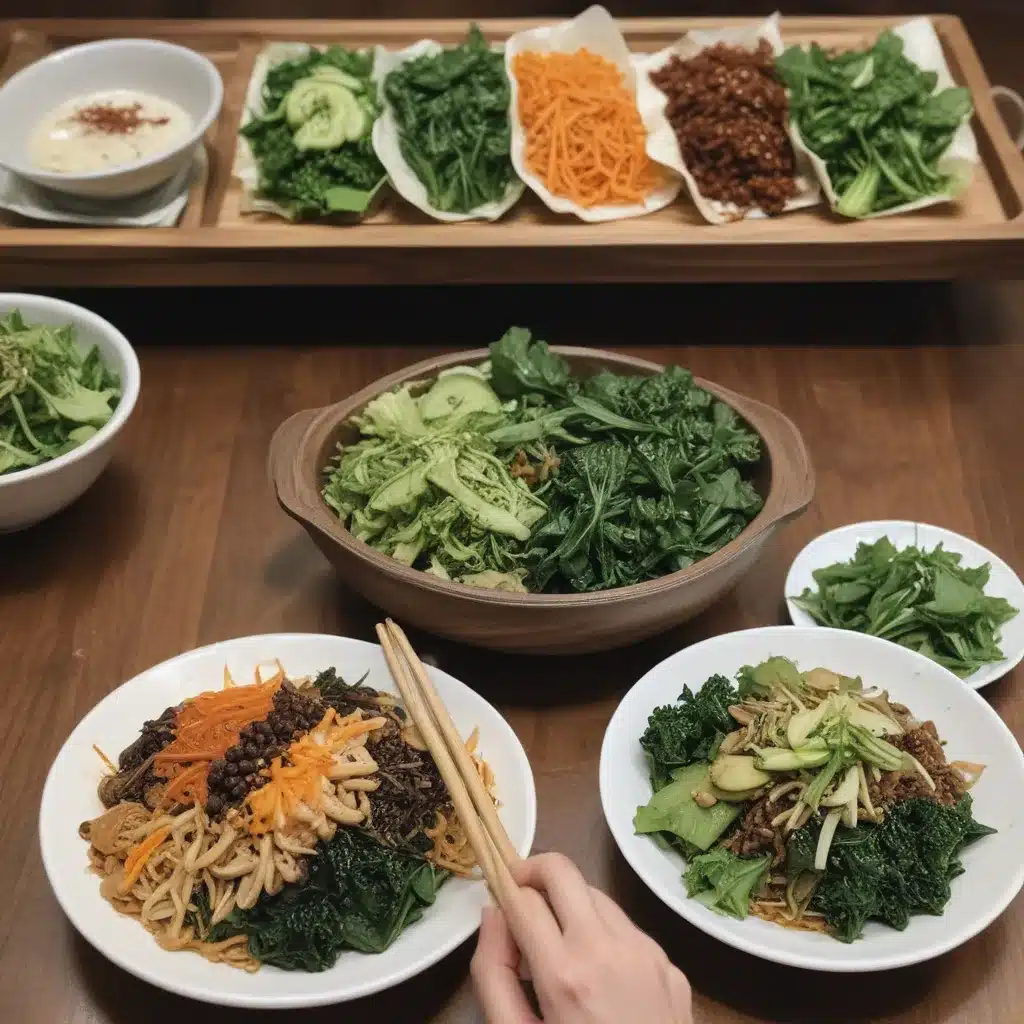
Discovering the Diverse Flavors of Korean Temple Cuisine
As I stepped into the serene dining hall of Hwaeomsa Temple, nestled in the foothills of Jirisan mountain, the chewing sounds instantly captivated me. The rhythmic crunches and slurps were not what I had expected from a Buddhist monastery—I had envisioned tranquil silence, perhaps punctuated by the gentle chants of monks. Instead, I found myself surrounded by a symphony of mindful mastication, where each bite seemed to hold the weight of a deep spiritual practice.
My Koreatown coauthor, Deuki Hong, and I had traveled to this remote temple, along with photographer Alex Lau, to immerse ourselves in the world of Korean temple cuisine. We had heard the stories of monk-chef Jeong Kwan and her artful, plant-based culinary creations, but we were determined to uncover the diverse flavors and philosophies that existed beyond the Netflix-fueled hype. [1]
As we observed the monks and nuns at Hwaeomsa enjoy their breakfast, I was struck by the remarkable simplicity and purity of their meal. The deep-hued doenjang-jjigae (fermented soybean stew), the vibrant baechu kimchi (napa cabbage kimchi), and the delicate, marinated dubu (tofu)—all of it prepared without a single onion, garlic, or leek in sight. This was temple cuisine in its most honest and unadorned form, a culinary practice that reflected the core tenets of Korean Buddhism: respect, gratitude, and the interconnectedness of all life. [2]
Exploring the Nuances of Temple Cuisine
As I conversed with Younglim Kim, the team lead at the Cultural Corps of Korean Buddhism, I learned that the Jeong Kwan narrative, while captivating, was just one small part of a much larger and more complex story. “The spirit of temple food that monk Jeong Kwan mentioned is respect and gratitude for all life, and all life is connected,” she observed. “However, the food culture varies, and the temple food of Jeong Kwan does not apply equally to other temples or other regions.” [2]
This revelation challenged my preconceptions about Korean temple cuisine. I had envisioned a monolithic tradition, but in reality, it was a tapestry of regional and individual expressions, each with its own unique flavors and philosophies. At Jinkwansa Temple, for instance, we met chief monk Gye Ho, who spoke passionately about the connection between cooking and spiritual practice. “Cooking is the extension of my practice. Feeding the body is the same as feeding the mind,” she told us. [2]
Even the issue of meat consumption within Korean Buddhism proved to be more nuanced than I had anticipated. While the general principle is to “not kill animals or any living beings,” Gye Ho acknowledged that some elderly monks over 80 years old may occasionally consume meat or fish, though not by their own hand. This complex reality underscored the fact that Korean temple cuisine is not a monolith, and that the Jeong Kwan narrative, while captivating, is but one thread in a tapestry of diverse culinary and spiritual traditions. [2]
Embracing the Creativity and Humility of Temple Cuisine
As Deuki and I continued our temple food tour, we encountered an array of creative and humble expressions of this ancient culinary tradition. At Hwaeomsa, we marveled at the chef’s foundational stock, a harmonious blend of Korean seaweed, foraged shiitake mushrooms, and homemade doenjang. And at Jinkwansa, we had the privilege of learning to make fresh dubu (tofu) using the traditional mot dol, a large stone grinder, under the guidance of chief monk Gye Ho. [2]
In contrast to the high-profile accolades and global attention surrounding Jeong Kwan, these temple chefs and monks approached their craft with a profound sense of humility and reverence. Their focus was not on flashy presentation or Michelin-worthy dishes, but rather on the purity of ingredients and the embodiment of their spiritual practice through the act of nourishing the body. [2]
This discovery challenged my own assumptions about the role of food in our lives. I realized that temple cuisine was not merely a culinary pursuit, but a holistic way of living that embraced the interconnectedness of all things. By stripping away the unnecessary layers of complexity, these practitioners were able to reveal the innate beauty and power of plant-based ingredients, allowing the flavors to speak for themselves. [2]
The Future of Temple Cuisine: Beyond a Single Narrative
As our temple food tour drew to a close, I couldn’t help but reflect on the broader implications of this ancient culinary tradition. While the Jeong Kwan narrative has undoubtedly played a pivotal role in bringing Korean temple cuisine to the global stage, Younglim Kim’s words echoed in my mind: “Over 1,700 years have passed since Buddhism was introduced to Korea, and since recipes are being passed down, Jeong Kwan cannot represent them all.” [2]
Indeed, the future of temple cuisine holds the promise of a rich tapestry of stories, flavors, and perspectives. As more people around the world embrace plant-based eating and the pursuit of mindfulness, the demand for authentic and soulful culinary experiences like those found in Korean temples will only continue to grow. [2]
For me, this journey has been a profound reminder that true nourishment goes beyond the physical body. By embracing the humility, creativity, and spiritual essence of temple cuisine, we can unlock a deeper understanding of ourselves and our place within the interconnected web of life. Whether you’re a seasoned Korean food enthusiast or a newcomer to the world of plant-based cooking, the temple food tour awaits, promising to awaken your senses and nourish your soul. [2]
References
[1] Gordinier, J. (2015). Jeong Kwan, the Philosopher-Chef. The New York Times Magazine. Retrieved from https://www.nytimes.com/2015/10/16/t-magazine/jeong-kwan-the-philosopher-chef.html
[2] Rodbard, M. (2022). The Korean Temple Food Not Seen on Netflix. Taste Cooking. Retrieved from https://tastecooking.com/the-korean-temple-food-not-seen-on-netflix/
[3] Kim, S. (2015). Korean Temple Foohobak Mandu Dumplings. Korean Bapsang. Retrieved from https://www.koreanbapsang.com/korean-temple-foohobak-mandu-dumplings/
[4] Longest, S. (2020). Holistic Meal Plan. Seonkyoung Longest. Retrieved from https://seonkyounglongest.com/holistic-meal-plan/
[5] Powered by Plantz. (2020). Big Batch Vegan Kimchi. Powered by Plantz. Retrieved from https://poweredbyplantz.com/big-batch-vegan-kimchi/
[6] Park, M. (2017). Korean Buddhist Temple Cuisine with Jeong Kwan. Mina Park. Retrieved from http://minapark.com/journal/2017/3/31/korean-buddhist-temple-cuisine-jeong-kwan
[7] Frifran. (n.d.). Gluten-Free Vegan Kimchi. Frifran. Retrieved from https://www.frifran.com/recipes/salads-sides-and-foundations/gluten-free-vegan-kimchi/
[8] Park, M. (2017). Buddha’s Birthday with Jeong Kwan. Mina Park. Retrieved from http://minapark.com/journal/2017/6/buddhas-birthday-with-jeong-kwan
